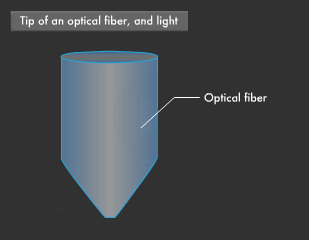Canon Science Lab
Near-Field Light
Near-field light is "dripping light" that can be observed under specific conditions. Employing this near-field light leads the way to observation of materials smaller than the wavelength of light, beyond the "diffraction limit of light."
Because light is a wave, it has a wavelength, and a diffraction limit. (For details, see "Why does my bathroom light appear dim?") Because of the diffraction limit, materials smaller than the light's wavelength cannot be observed with a microscope using ordinary optical lenses. However, in the field of nanotechnology, needs exist to observe nanometer-sized or even smaller materials, and special microscopes employing a near-field light source are used. Diverse research is being conducted on this special light, which is beginning to find further applications outside microscopy.
Light Is Blocked When Confronted with a Smaller Diameter Space Than Its Wavelength
If you are forced into a very narrow space, you'll find that any movement of your legs and arms is impossible. Now imagine that your leg and arm movements are a wavelength. Light waves, too, find it impossible to move if they are confronted with a small space. This is our departure point for thinking about near-field light. Let's first consider light traveling along an optical fiber. Light waves can travel freely along optical fibers that are even much thinner than human hair. This is because the diameter of the optical fiber is bigger than their wavelength.

What happens, then, if the diameter of the fiber is smaller than that wavelength? The light waves find it impossible to assume their proper form because of the lack of space. They are unable to move as they should, and so make no progress along the fiber. In fact, if you go on reducing the width of optical fibers, you eventually arrive at a point at which light does not penetrate.
How "Dripping Light" is Created
However, a certain tiny amount of dripping light does, in fact, penetrate from the tip of an optical fiber. This is near-field light.
This phenomenon occurs because the point of incidence, where the incident beam strikes a surface, and the point of reflection are not absolutely the same, even in total reflections, or cases in which the entire incident light is reflected at the surface.

These points are deemed to be the same at the level of high school physics, and in general there's no problem with doing so, but the fact is that they are separated by a distance of one wavelength.
In cases of total reflection, a tiny portion of the incoming light spills over, and as shown in the diagram below, makes a detour of one wavelength before arriving at the point of reflection, where reflected light emerges as if reflected from a single point. The light that spills over is near-field light. Light possesses this property to spill over, and the dripping light appearing at the tips of optical fibers is near-field light that has spilled over.
Using Near-Field Light
Using near-field light enables the observation of sub-wavelength materials invisible with ordinary optical microscopes. Microscopes using near-field light are known as near-field optical microscopes. They illuminate materials with near-field light and observe dispersed light from the side. Many kinds of microscopes have been developed for nanotechnology research, but near-field optical microscopes stand out for the rich data they yield on the specimen being investigated.

Diverse research activities are also being conducted on the application of near-field light in other areas. For example, applying near-field light for ultra-dense writing and reading of optical storage media such as CDs and DVDs would enable a dramatic increase in the amount of data a single disk can store. Near-field light also holds much promise for the semiconductor production field, as it could allow ultrafine patterning technologies, opening the way for the fabrication of ultra-small high-performance devices.
